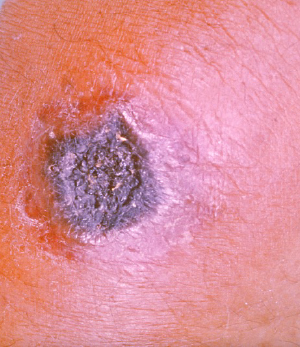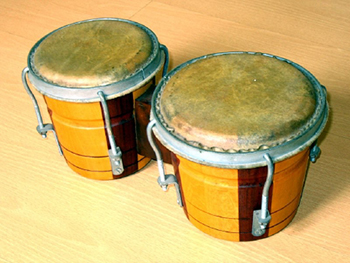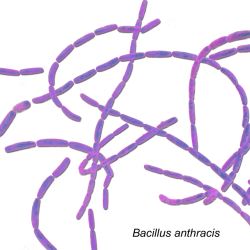Jane Campion takes home the 2022 Oscar for Best Director in "The Power of the Dog," an unsettling, psychological Western drama. The tension is due to the relationship of the main character, Phil Burbank, with his brother's new wife and her son, Peter. Phil, to put it bluntly, is a bully. However, young Peter is training to become a medical doctor and [spoiler alert] uses his knowledge of pathogens to destroy an unwitting Phil. How did making a rawhide rope lead to death?
The answer is in the soil: a ubiquitous, spore-forming bacteria called Bacillus anthracis. B. anthracis is the causative agent of anthrax, primarily a disease of herbivores such as cattle and bison. Anthrax is derived from  the Greek word anthrakis, which means coal. When these Bacilli infect the skin, they produce black, coal-like lesions. Anthrax occurs worldwide, especially in temperate, agricultural regions with alkaline soils. Grazing livestock comes into contact with the bacterial spores in the soil by ingesting them directly from overgrazed pastures or after flooding when the spores rise to the surface of a field. Occupational exposure from handling infected livestock, wild animals, or their tissues and hides is the usual cause of anthrax infection in people.
the Greek word anthrakis, which means coal. When these Bacilli infect the skin, they produce black, coal-like lesions. Anthrax occurs worldwide, especially in temperate, agricultural regions with alkaline soils. Grazing livestock comes into contact with the bacterial spores in the soil by ingesting them directly from overgrazed pastures or after flooding when the spores rise to the surface of a field. Occupational exposure from handling infected livestock, wild animals, or their tissues and hides is the usual cause of anthrax infection in people.
The bacteria enter the body through a break in the skin; this was the cause of Phil Burbank’s death. Phil had open wounds on his hands while washing, twisting, and braiding infected rawhide (provided by Peter, the victim of his bullying). B. anthracis, if caught early, can be knocked out with antibiotics such as penicillin and doxycycline. Without antibiotic treatment, the death rate for cutaneous anthrax is about 20%. Phil’s machismo, ‘manifested’ by his failure to seek immediate medical care, in the presence of cutaneous anthrax’s symptoms of high temperature, trembling, and convulsions were the deciding factor in his demise.
Should we be worried? How often do humans contract anthrax? Will my dog get anthrax from a rawhide bone? The answers are no, not often, and no. According to the Centers for Disease Control and Prevention (CDC), anthrax in livestock is controlled primarily through vaccinations. Rapid case detection and reporting, coupled with burning or deep burial of infected or suspicious dead animals, also prevents the spread of the disease. By reducing infection in livestock, veterinary supervision of slaughterhouses, and restricting importation of hides and wool from anthrax-affected countries, human infection in the United States is quite rare.
The most common exposure to anthrax is through the skin. The last reported cutaneous case in the United States was in 1992. Of course, the CDC cited naturally occurring cases and didn’t include the anthrax cases induced by weaponizing B. anthracis for human infection by inhalation. In 2001, B. anthracis spores were mixed into powders for easy dispersal into the air. These powders were deliberately placed into letters and mailed to targeted individuals. Twenty-two people got anthrax, and five died. However, the morbidity and mortality due to naturally transmitted anthrax are close to zero.
Infection by bongo.
 In Florida, in 1974, a documented anthrax case was linked to a hide drum - a goat hide bongo purchased in Haiti, where anthrax was common. A fatal case of inhalation anthrax was reported in Scotland in 2006, apparently from handling contaminated hide drums from West Africa. The US Department of Agriculture regulates the importation of processed and unprocessed hides. Animal hides treated (tanned or pickled) may be imported. The CDC recommends that drummers purchase instruments made from domestically-produced hides or an importer using appropriate governmental inspection.
In Florida, in 1974, a documented anthrax case was linked to a hide drum - a goat hide bongo purchased in Haiti, where anthrax was common. A fatal case of inhalation anthrax was reported in Scotland in 2006, apparently from handling contaminated hide drums from West Africa. The US Department of Agriculture regulates the importation of processed and unprocessed hides. Animal hides treated (tanned or pickled) may be imported. The CDC recommends that drummers purchase instruments made from domestically-produced hides or an importer using appropriate governmental inspection.
Rawhide chews for dogs
Those chews our dogs love come with risks; potential choking hazards, canine tooth damage, diarrhea, vomiting, and exposure to harmful chemicals from the tanning process. But, there is no mention of anthrax exposure by rawhide chews in the literature. Apparently, processing and tanning eliminate Bacillus spores in these products.
You can start your day knowing that it will, in all probability, remain anthrax free. For those who remain worried: avoid tissues and hides of dead animals, wear protective equipment such as gloves when butchering meat or game, and buy your bongos and drums from reputable sources.

